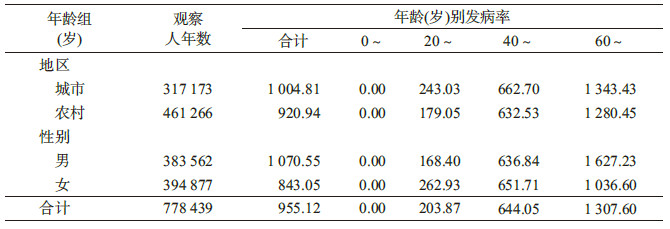文章信息
- 胡如英, 龚巍巍, 王蒙, 潘劲, 武海滨, 费方荣, 何青芳, 俞敏.2015.
- Hu Ruying, Gong Weiwei, Wang Meng, Pan Jin, Wu Haibin, Fei Fangrong, He Qingfang, Yu Min.2015.
- 2型糖尿病与恶性肿瘤发病风险关系的队列研究
- Association between type 2 diabetes mellitus and risk of cancers: a cohort study
- 中华流行病学杂志, 2015, 36(12): 1384-1386
- Chinese Journal of Epidemiology, 2015, 36(12): 1384-1386
- http://dx.doi.org/10.3760/cma.j.issn.0254-6450.2015.12.014
-
文章历史
- 投稿日期: 2015-05-14
众多研究显示2型糖尿病与恶性肿瘤的发生风险显著相关[1, 2, 3],但目前国内尚缺乏队列研究和相关依据分析。为此本研究在大人群监测队列基础上,探讨2型糖尿病与恶性肿瘤发生风险之间的关系。
资料与方法1. 资料来源:糖尿病、肿瘤患者发病资料源自浙江省卫生监测区2007-2013年慢性病监测和生存随访数据库,人口资料来源于各监测区公安部门人口报表。
2. 监测概况:浙江省卫生监测区建于2001年,2006年全人群开展死因监测和糖尿病、肿瘤、脑卒中和冠心病急性事件发病监测;发病监测基于医院HIS系统数据对接交换为主,医生填报、社区补报、死亡补发为辅,医院防保科每月开展医院漏报自查,各级疾病预防控制中心负责报告卡质量审核、查重及半年1次漏报检查,社区卫生服务中心负责辖区糖尿病、肿瘤等病例基本信息、发病信息初访核实,每年对病例开展1次随访,收集生存质量、死亡日期和原因、户口变迁等信息;疾病编码统一采用ICD-10、ICD-O-3,通过《浙江省慢性病监测信息管理系统》网络收集医院、疾病预防控制中心、社区监测和生存随访管理信息,并实现各地区监测数据网络互流互通。糖尿病发病监测包括1和2型、妊娠和其他新发确诊糖尿病病例;恶性肿瘤发病监测包括所有确诊新发恶性肿瘤和中枢神经系统肿瘤。
3. 监测方法:利用2007-2013年人群糖尿病、肿瘤发病监测和生存随访队列资料,建立糖尿病患者肿瘤发病数据库,计算糖尿病患者肿瘤发病率、一般人群肿瘤发病率、糖尿病患者肿瘤发生相对危险度(RR)。以2007-2013年浙江省卫生区监测人口构成作为标准人口,计算标准化发病率。
4. 统计学分析:数据分析使用SAS 9.1.3统计软件; 以率为主要分析指标,采用χ2检验、趋势性χ2检验,P≤0.05为差异有统计学意义。
结 果1. 糖尿病和肿瘤发病特征: 2007-2013年浙江省卫生监测区监测覆盖114 808 053人,报告糖尿病新发病例327 268例,发病率为285.06/10万,其中男性281.41/10万,女性288.81/10万,女性高于男性(χ2=2.73,P<0.000 1); 报告肿瘤319 048例,发病率为277.90/10万,其中男性为318.12/10万,女性为236.52/10万,男性发病率高于女性,差异有统计学意义(χ2=9.41,P<0.000 1)。糖尿病、肿瘤发病率无论男性还是女性均随年龄增加而上升(表1)。城乡糖尿病发病率分别为319.77/10万和265.84/10万,肿瘤发病率分别为298.85/10万和266.30/10万,两者均为城市高于农村(χ2=6.31,P<0.000 1;χ2=2.50,P<0.000 1),并随年龄增长而增加(表2)。
2. 糖尿病患者肿瘤发病特征: 327 268例糖尿病患者中,有2 318例失访,17 896例死亡,两者占随访患者总数的6.18%,共随访观察778 439人年,累计新发肿瘤7 435例,糖尿病患者肿瘤发病率为955.12/10万,其中城市和农村分别为1 004.81/10万和920.94/10万,男性和女性分别为1 070.55/10万和843.05/10万,城市高于农村(χ2=16.00,P<0.000 1),男性高于女性(χ2=24.15,P<0.000 1);糖尿病患者肿瘤发病率随年龄增加,60岁前女性高于男性,60岁后男性高于女性。糖尿病患者肿瘤标化率为458.05/10万,是一般人群肿瘤发病率的1.64倍(表3)。
3. 糖尿病患者肿瘤发病风险: 糖尿病患者发生肿瘤的风险是非糖尿病人群的1.68倍(95%CI: 1.68~1.70);20~39岁糖尿病患者发生肿瘤的风险最高(RR=4.34,95%CI:3.54~5.32),随着年龄增加,风险降低,但60岁以上糖尿病患者与肿瘤发病风险仍存在关联(RR=1.21,95%CI:1.18~1.25)(表4)。
2007-2013年浙江省慢性病监测结果显示,恶性肿瘤、糖尿病的发病率已分别达到277.90/10万和285.06/10万,肿瘤发病率接近2010年全国肿瘤登记报告水平(276.16/10万)[4];糖尿病、肿瘤发病率无论男性还是女性均随年龄增加而上升,且城市均高于农村,其中肿瘤发病率男性高于女性,糖尿病则女性略高于男性。
20世纪初Maynard[5]就提出糖尿病与肿瘤的统计学相关性,近年来国外大量研究也发现糖尿病与肿瘤存在关联[1, 2, 3, 6, 7, 8]。但国内鲜见相关研究。本文基于监测数据的前瞻性队列研究,显示T2DM患者肿瘤发病率为955.12/10万,标化发病率为458.05/10万,T2DM患者肿瘤发病率是一般人群的1.64倍,明显高于一般人群;T2DM患者发生肿瘤的风险是非糖尿病人群的1.68倍(95%CI: 1.68~1.70),与恶性肿瘤发病风险存在相关性,结果与上述相关研究基本一致。糖尿病增加肿瘤风险的部分原因可能为两者之间存在高龄、性别、种族、超重/肥胖、饮食、体力活动、吸烟和饮酒等共同危险因素,直接关联的可能机制是高胰岛素血症、高血糖和炎性反应等[9, 10, 11, 12]。
研究结果显示,糖尿病患者肿瘤发病率呈现城市高于农村,60岁前女性高于男性,60岁后男性高于女性,并随年龄增长而增加的流行特征;发病风险却随年龄增加而降低,20~39岁糖尿病患者肿瘤发生的风险最高,60岁以上糖尿病患者肿瘤发病风险最低,但仍存在风险关联。其原因可能与新发糖尿病患者患肿瘤的可能性更大,并随糖尿病病程进展血胰岛素水平减少有关[2, 13, 14, 15]。
基于以上结果建议将糖尿病人群作为肿瘤高危人群,定期进行相关肿瘤筛查,同时应积极鼓励糖尿病患者健康饮食,体育锻炼,控制体重,降低肿瘤发生风险。
| [1] Larsson SC,OrsiniN,Wolk A. Diabetes mellitus and risk of colorectal cancer:a meta-analysis [J]. J Natl Cancer Inst,2005,97(22):1679-1687. |
| [2] Mori M,Saitoh S,Takagi S,et al. GlyceSic control and prostate cancer progression:results from the search database [J]. A Sian Pac J Cancer Prev,2000,1(4):269-276. |
| [3] Stovring H,Andersen M,Beek-Nielsen H,et al. Rising prevalence of diabetes:evidence from a Danish pharmacy-epidemiological database [J]. Lancet,2003,362:537-538. |
| [4] Office of the National Cancer Prevention and Control Research. Chinese Cancer Registry Annual Report (2010) [M]. Beijing:Military Medical Science Press,2011. (in Chinese) 全国肿瘤防治研究办公室.中国肿瘤登记年报(2010)[M]. 北京:军事医学科学出版社,2011. |
| [5] Maynard GD. A statistical study in cancer death-rates [J]. Biometrika,1910,7(3):276-304. |
| [6] Michels KB,Solomon CG,Hu FB,et al. Type 2 diabetes and subsequent incidence of breast cancer in the Nurses,Health Study [J]. Diabetes Care,2003,26:1752-1758. |
| [7] Krechler T,Novotny J,Zeman M,et al. Pancreatic carcinoma and diabetes mellitus[J]. Cas Lek Cesk,2004,143:97-100. |
| [8] Lu Y,Fang Y,Wang QQ,et al. A retrospective-analysis of the correlation between diabetes mellitus and cancer [J]. Chin J Endocrinol Metab,2010,26(3):183-187. (in Chinese) 卢瑜,方勇,王青青,等. 糖尿病与恶性肿瘤关系的回顾性临床研究[J]. 中华内分泌代谢杂志,2010,26(3):183-187. |
| [9] Goodwin PJ,Ennis M,Bahl M,et al. High insulin levels in newly diagnosed breast cancer patients reflect underlying insulin resistance and are associated with components of the insulin resistance syndrome [J]. Breast Cancer Res Treat,2009,114:3517-3525. |
| [10] Chang CK,Ulrich CM. Hyperinsulinaemia and hyperglycaemia:possible risk factors of colorectal cancer among diabetic patients [J]. Diabetologia,2003,46(5):595-607. |
| [11] Cai J,Wang HS. Leptin and leptin receptor in patients with primary hepatocellular carcinoma relationship between expression and clinical pathological characteristics [J]. Shandong Med J,2011,51(44):85-86. (in Chinese) 蔡俊,王宏升. 原发性肝细胞癌患者组织中瘦素及其受体表达与临床病理特征的关系 [J]. 山东医药,2011,51(44):85-86. |
| [12] Guo LW,Li N,Wang G,et al. Body mass index and cancer incidence:a prospective cohort study in northern China [J]. Chin J Epidemiol,2014,35(3):231-236. (in Chinese) 郭兰伟,李霓,王刚,等. BMI与恶性肿瘤发病风险的前瞻性队列研究 [J]. 中华流行病学杂志,2014,35(3):231-236. |
| [13] Hu FB,Manson JE,Liu S,et al. Prospective study of adult onset diabetes mellitus (type 2) and risk of colorectal cancer in women [J]. J Natl Cancer Inst,1999,91(15):1334. |
| [14] Chen YF,Tong JD. Clinical analysis of the relationship between diabetes and pancreatic cancer [J]. J Clin Med Pract,2010,14 (1):75-77. (in Chinese) 陈玉芳,童建东. 糖尿病与胰腺癌关系的临床分析 [J]. 实用临床医药杂志,2010,14(1):75-77. |
| [15] Zeng CP,Chen YP,Yang QS,et al. Association of diabetes mellitus with biological behaviors of colorectal cancer [J]. Chin J Gastronintest Surg,2011,14(3):196-198. (in Chinese) 曾春平,陈幼萍,杨清水,等. 糖尿病与结直肠癌及其生物学行为的关系 [J]. 中华胃肠外科杂志,2011,14(3):196-198. |
 2015, Vol. 36
2015, Vol. 36






